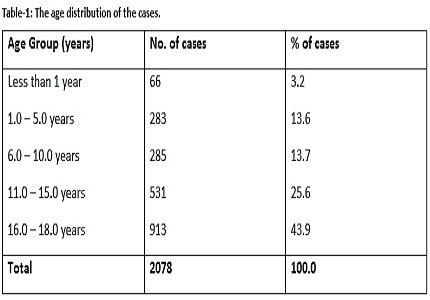Spectrum of Pediatric Dermatoses in The Pediatric Outpatient Clinic of a Rural Teaching Hospital
Abstract
Introduction: Skin diseases in the pediatric population are common all over the world including rural and urban areas. There is variation in the pattern and presentation of Dermatoses, with eczemas being the most common skin disorder in developountries and infections and infestations in the developing countries.
Aims and Objectives: i) To study the spectrum of various dermatoses in infants and children attending pediatric outpatient clinic. ii) To study the pattern of common Dermatological conditions affecting the pediatric population of different age groups. Material & Methods: It was an observational retrospective database study of the spectrum of various dermatoses in infants and children attending pediatric outpatient clinic over past 6 months from July 2016 to December 2016. We included all patients coming with skin disorders to the pediatrics outpatient department.
Results: The entire data was entered and cleaned in MS Excel before its statistical analysis. Among 2078 pediatric skin patients attending the Dermatology OPD, 597 cases were Infectious and 1481 cases were Non infectious. Males outnumbered the females. The distribution of diagnosis of dermatoses differs significantly between male and female cases studied (P-value<0.001). Three most common spectrums of dermatoses were pityriasisinfections (17.5%), Atopic dermatitis (11.4%) and Tinea infections (10.5%). Tinea infections were found to be highest (36.7%) and next common was scabies (24.5%) in Infectious variety followed by Chicken –pox / Varicella (7.7%).
Conclusion: Over all fungal infections, Atopic Dermatitis and Pytiriasis were commonest which commonly occurred in adolescents and teen age groups which could be attributed to hormonal changes, excessive sweating, and bad hygiene.
Downloads
References
2. Sharma S,Bassi R,Manmeet KaurS. Epidemiology of dermatoses in children and adolescents in Punjab, India.Journal of Pakistan Association of Dermatologists;2012;22 (3):224-229.
3. Jain N, Khandpur S. Pediatric dermatoses in India: Indian Journal of Dermatology, Venereology, and Leprology.Vol. 76, No. 5, September -October, 2010, 76(5) 451-454.DOI:10.4103/0378-6323.69034.
4. Shrestha R, Shrestha D, Dhakal AK, Shakya A, Shah SC, Shakya H.Spectrum of pediatricdermatoses in tertiary care center in Nepal. Nepal Med Coll J. 2012 Jun;14(2):146-8. [PubMed]
5. Karthikeyan K, Thappa D, Jeevankumar B. Brief Report. Pattern of Pediatric Dermatoses in a Referral Center in South India. Indian Pediatrics 2004 April (41):374-377.
6. Poudyal Y, Ranjit A, Pathak S, Chaudhary N. Pattern of Pediatric Dermatoses in a Tertiary Care Hospital of Western Nepal. Dermatology Research and Practice.2016; 1-5.
7. Giri V, Giri O, Gupta S, Kanodia S. Clinico-Epidemiological Profile of Inflammatory and Infective Skin Diseases In A Tertiary Care Centre In East India. International Journalof Medical Research and Health Sciences: 2014: 3(4): 892-896. DOI:10.5958/2319-5886.2014.00021.6.
8. Das KK. Pattern of dermatological diseases in Gauhati medical college and hospital Guwahati. Indian J DermatolVenereolLeprol 2003;69: 16-18.
9. Devi T, Zamzachin G, “Pattern of skin diseases in Imphal. Indian J Dermatolgy, 2006; 51: 149-50.
10. Gangadharan C, Joseph A, Sarojini PA. Pattern of Skin Diseases in Kerala. Indian J DermatolVenereolLeprol. 1976 Mar-Apr;42(2):49-51. [PubMed]
11. Grover S, Ranyal RK, Bedi MK. A cross section of skin diseases in rural Allahabad. Indian J Dermatol. 2008;53(4):179-81. doi: 10.4103/0019-5154.44789. [PubMed]
12. Sayal SK, Das AL, Gupta CM. Pattern of skin diseases among civil population and armed forces personnel at Pune. Indian J DermatolVenereolLeprol. 1997 Jan-Feb;63(1):29-32. [PubMed]
13. Dayal SG, Gupta GD. A Cross Section of Skin Diseases in Bundelkhand Region, UP. Indian J DermatolVenereolLeprol. 1977 Sep-Oct;43(5):258-261. [PubMed]
14. Blanc Rosa Del Pozzo- Magana, AljandroLazo – Langner, et al. International Scholarly Research Network ISRN Dermatology. 2012:Article ID 351603: 1-5. DOI:10.5402/2012/351603.
15. Safa Suleman Elfaituri. Indian Journal Of Pediatric Dermatology: April-June 2015; 16 (2); 64-71.DOI:10.4103/2319-7250.152125.
16. Sharma NL, Sharma RC. Prevalence of dermatologic diseases in school children of a high altitude Tribal Area of Himachal Pradesh. Indian Journal DermatolVenereolLeprol 1990: 56; 375-376.
17. Kumar V, Garg BR, Baruah MC. Prevalence of Dermatological Diseases in School Children in a Semi- Urban Area in Pondicherry. Indian J DermatolVenereolLeprol. 1988 Nov-Dec;54(6):300-302. [PubMed]
18. Bilal Sula, DeryaUçmak, Günay Saka, SedatAkdeniz, Engin Yavuz, Yunus Yakut, Evrim Arslan, Hamza Aktaşş, Mehmet Yıldız, Sibel Yolbir, and RukenAzizoğlu: Prevalence of skin disorders among primary school children in Diyarbakir, Turkey : Arch Argent Pediatr 2014;112 (5): 434 - 438.

Copyright (c) 2017 Author (s). Published by Siddharth Health Research and Social Welfare Society

This work is licensed under a Creative Commons Attribution 4.0 International License.


 OAI - Open Archives Initiative
OAI - Open Archives Initiative


